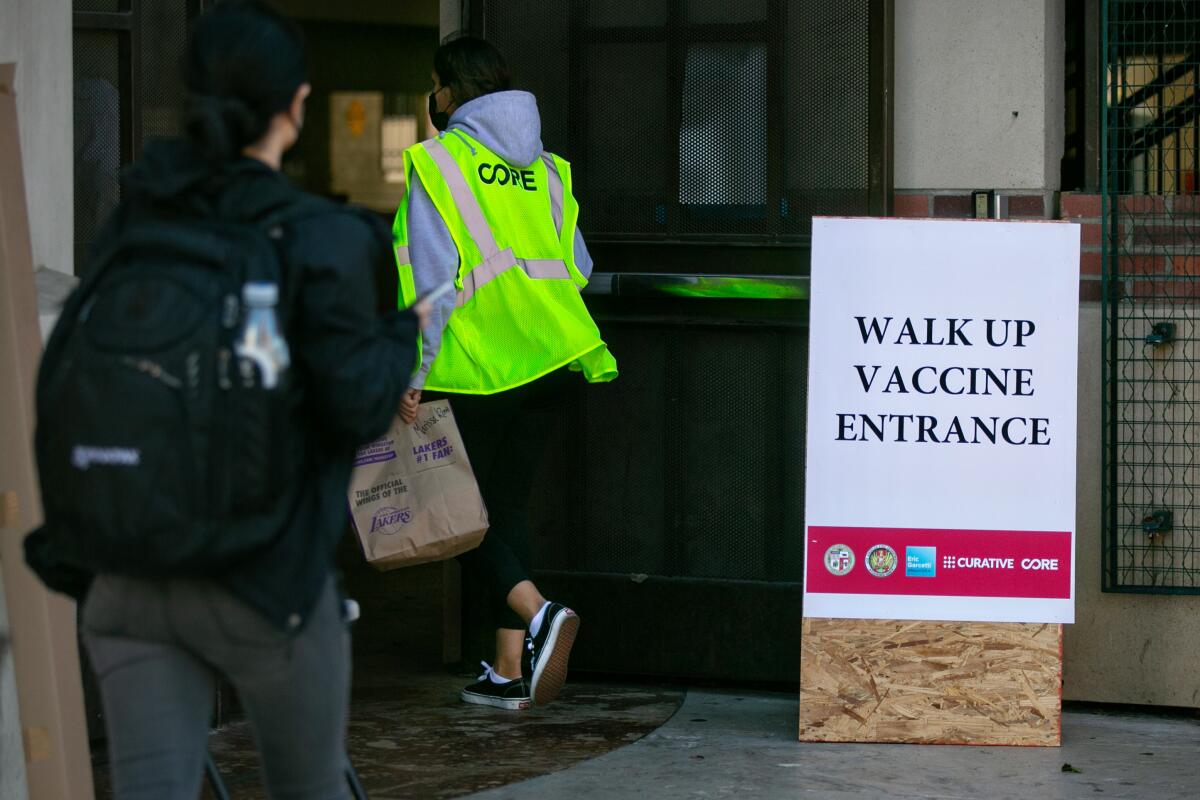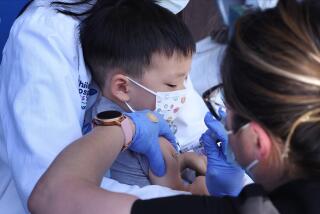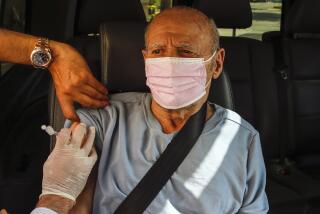Millions more Californians will be eligible for COVID-19 vaccine. But they face obstacles

Millions of Californians with disabilities and underlying health conditions will become eligible for the COVID-19 vaccine on Monday, but continuing shortages of doses as well as ongoing uncertainties about verification and qualification still pose potential barriers to access.
The expansion marks an important step for the state’s emergence from the pandemic, and new guidance released Thursday by health officials allows high-risk people to self-attest to their eligibility — a key win for advocates who worried that people would not be able to gather documentation to verify their disability or underlying condition.
But the addition of an estimated 4.4 million Californians to the eligibility list will place additional burdens on a vaccine supply that has grown steadily but not significantly. California is reserving 40% of its supply for people in underserved communities and 10% for teachers. And there are still many people 65 and older who are waiting for their vaccinations as well.
Further straining tight supplies: The state on Monday is also expanding eligibility to people who live or work in high-risk congregate residential settings, such as homeless shelters and incarceration facilities, and to public transit and airport employees.
President Biden, expressing confidence in supply projections during his national address Thursday night, said he believed every adult could be vaccinated by the end of May.
The high-risk group of newly eligible individuals comprises 10 categories: those who are pregnant or have cancer; chronic kidney disease of stage 4 or above; chronic pulmonary disease; Down syndrome; a compromised immune system from solid organ transplant; sickle cell disease; heart conditions such as heart failure, coronary artery disease and cardiomyopathies (excluding hypertension); severe obesity; and Type 2 diabetes mellitus.
With population estimates for Monday’s group ranging from 4 million to 5 million, and with other eligible groups totaling some 13 million, nearly half of all Californians will be eligible for the vaccine.
For those with disabilities and advocates, who have long lobbied for access, eligibility could not come soon enough. In 2020, 86% of people who died of COVID-19 in L.A. County had an underlying condition, according to the Public Health Department.
“There is a huge sense of urgency for this group, said L.A. resident Sarah Sultan, 35, who is pregnant and diabetic. “This group as a whole is much more likely to have severe COVID, be hospitalized and die from COVID.”
Yet many members of the high-risk group said they have been in the dark about where to go, what to do and how to prove their eligibility. And because of unclear language over the definition of some medical conditions, some people are still wondering whether they qualify, including people with asthma.
Some of those questions were addressed in guidance the California Department of Public Health released Thursday night. The details included some specific examples of people who would qualify for eligibility but are not explicitly listed, including those who use independent living centers, in-home supportive services and community-based adult services.
The new guidance’s allowance for self-attestation clears up confusion about how high-risk people can prove their eligibility. Advocates have long pressed for a process that would not create unnecessary barriers, especially for those who are less mobile or intellectually disabled. Under the guidelines, people do not have to disclose what condition that they have, only that they are eligible, Dr. Paul Simon, chief science officer with the L.A. County Department of Public Health, said Friday.
“It’s great news,” said Emma Alvarez-Gibson, 45, who is diabetic and has been in quarantine for a year. “High-risk people have been been extraordinarily careful from the start. Many of us feel a bit toyed with, given the way the state has flip-flopped.”
Officials have for weeks said that they were working on such guidance. Its absence had fueled much anxiety, with many in the at-risk community saying they have yet to hear from their doctors or from the state’s My Turn system.
“Neither of the systems that were meant to keep me informed has actually done that,” Alvarez-Gibson said.
Appointment slots for people with underlying conditions should open up Monday, Simon said.
In creating the latest eligibility group, the 10 categories that qualify for the vaccine were pulled from a Centers for Disease Control and Prevention list of underlying issues with known evidence of high risk from COVID-19.
The state also includes a broader, non-specific category of “individuals who are likely to develop severe life-threatening illness or death from COVID.” Because that could be applied to a variety of other disabilities and underlying issues, it has left many people wondering whether they qualify.
Conditions such as asthma are not explicitly named, for example, and while Type 2 diabetes is, Type 1 diabetes is not. The broad language is meant to allow local health providers to use their best clinical judgment in determining who qualifies for the shot.
Dr. Jeffrey Luther, a member of the state’s vaccine advisory committee and a board member of the California Academy of Family Physicians, said Wednesday that he has fielded questions from patients asking about their eligibility.
“I got a message from a patient saying, ‘I have asthma and I’m obese. Does that mean I’m qualified?’” Luther said that without clear guidance, it’s been difficult to answer that question.
L.A. has also struggled with vaccine supply levels and is working to address issues related to mobility, accessibility and equity even as the new groups become eligible. Adding to that challenge is that fact that allocations of the Johnson & Johnson single-dose vaccine will come to a near halt over the next two weeks while the company works to ramp up production.
“Given the limited supply of vaccine, we will be greatly challenged by the expansion of eligibility,” Simon said Friday.
The state guidelines for at-risk people essentially trust residents to accurately disclose their eligibility, but some officials expressed concern that the lenient rules will be abused by people faking underlying conditions. People have forged documents and used access codes intended for use in high-risk communities.
Simon, at a news conference Friday, asked that residents not abuse the loose guidelines for at-risk people by faking eligibility. “We don’t feel that our front-line staff are in a position to screen and make decisions about who or who is not eligible,” he said. “We urge people not to take advantage of that.”
The county is creating restricted clinics for people with underlying conditions at large-capacity sites, Simon said, and county sites will provide drive-through lanes and accommodations for people with disabilities.
Officials urged people to work with their healthcare providers to seek vaccinations as their first step.
For their part, several healthcare groups in the region, including UCLA Health, Kaiser Permanente, Cedars-Sinai and the L.A. County Community Clinic Assn., said they will be using their electronic health records to identify patients in their systems that meet the clinical criteria and reaching out to them directly.
“Our hope is to vaccinate as many Kaiser Permanente members with underlying conditions as possible,” said Dr. Michael Morris, physician director of Kaiser Permanente Southern California’s COVID-19 Vaccination Program, adding that they have “already begun reaching out to all of our newly eligible members with underlying conditions, starting with those with the highest risk.”
Although it can be heartening to see sectors and activities reopen as more and more people get vaccinated, some in the at-risk community said it’s hard to shake the feeling they’ve been forgotten.
“Many [disabled and chronically ill people] have stayed totally isolated in their house for the last year,” Sultan said. “Many of us expected that this group would be able to receive the vaccine sooner and that information on how we make appointments would be clear…. Disabled, high-risk and chronically ill people have been treated as entirely disposable and irrelevant.”
Judy Mark, president of L.A.-based advocacy group Disability Voices United, said people with disabilities can feel powerless within the state because they don’t have a trade union like farmworkers or healthcare workers, and they don’t have paid lobbyists or formal representation as a voting bloc.
“Most of us are overwhelmed with our own lives,” she said. “We should have been on that list much earlier.”
Still, Monday’s expanded eligibility has given her reason to hope after a long, difficult and isolating year.
“I have to say, I haven’t felt this optimistic in a really long time,” she said.
More to Read
Sign up for Essential California
The most important California stories and recommendations in your inbox every morning.
You may occasionally receive promotional content from the Los Angeles Times.












